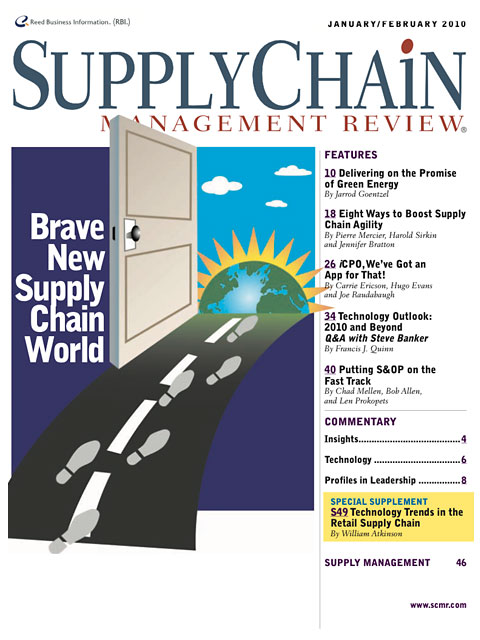Sorry, but your login has failed. Please recheck your login information and resubmit. If your subscription has expired, renew here.
January-February 2010
As the search for news forms of energy intensifies, supply chain professionals are presented with an unprecedented challenge and opportunity: To apply their managerial and analytical skills in delivering this energy to the end consumers. How effectively they respond may ultimately determine whether—and when—the promise of green energy finally gets fulfilled. Browse this issue archive.Need Help? Contact customer service 847-559-7581 More options
The surge in green energy investments is the modern equivalent of the Gold Rush. Researchers and entrepreneurs are exploring new frontiers from the windy Great Plains to the sunny Southwest in search of the mother lode. And like the original rush, this one is dominated by the challenges of turning a natural resource into a commercial proposition. However, an important part of very effort to deliver new forms of energy has been largely overlooked: the vital role of supply chain management.
Not even supply chain professionals are fully aware of the need to apply the analytical and managerial skills they routinely deploy to the delivery of green energy. For example, renewable resources such as wind and solar are, by nature, intermittent and located far away form consumer demand. In other words, the supply chain is often in the wrong place at the wrong time. Supply chain professionals have been addressing these mismatches for as long as their profession has existed.
For understandable reasons, the green energy effort is centered on how to generate supplies and on consumer applications such as hybrid or fuel cell vehicles. But before green energy can become a viable alternative to fossil fuels, we need to address the issue of how it can be delivered reliably and cost effectively to end consumers. This is where the supply chain comes in.
 |
This complete article is available to subscribers
only. Click on Log In Now at the top of this article for full access. Or, Start your PLUS+ subscription for instant access. |
SC
MR
Sorry, but your login has failed. Please recheck your login information and resubmit. If your subscription has expired, renew here.
January-February 2010
As the search for news forms of energy intensifies, supply chain professionals are presented with an unprecedented challenge and opportunity: To apply their managerial and analytical skills in delivering this energy… Browse this issue archive. Download a PDF file of the January-February 2010 issue.
 |
Download Article PDF |
The surge in green energy investments is the modern equivalent of the Gold Rush. Researchers and entrepreneurs are exploring new frontiers from the windy Great Plains to the sunny Southwest in search of the mother lode. And like the original rush, this one is dominated by the challenges of turning a natural resource into a commercial proposition. However, an important part of very effort to deliver new forms of energy has been largely overlooked: the vital role of supply chain management.
Not even supply chain professionals are fully aware of the need to apply the analytical and managerial skills they routinely deploy to the delivery of green energy. For example, renewable resources such as wind and solar are, by nature, intermittent and located far away form consumer demand. In other words, the supply chain is often in the wrong place at the wrong time. Supply chain professionals have been addressing these mismatches for as long as their profession has existed.
For understandable reasons, the green energy effort is centered on how to generate supplies and on consumer applications such as hybrid or fuel cell vehicles. But before green energy can become a viable alternative to fossil fuels, we need to address the issue of how it can be delivered reliably and cost effectively to end consumers. This is where the supply chain comes in.
 |
SUBSCRIBERS: Click here to download PDF of the full article. |
SC
MR

Latest Supply Chain News
- How CPG brands can deliver on supplier diversity promises
- How S&OP provides the answer to in-demand products
- AI, virtual reality is bringing experiential learning into the modern age
- Humanoid robots’ place in an intralogistics smart robot strategy
- Tips for CIOs to overcome technology talent acquisition troubles
- More News
Latest Podcast

 Explore
Explore
Latest Supply Chain News
- How CPG brands can deliver on supplier diversity promises
- How S&OP provides the answer to in-demand products
- AI, virtual reality is bringing experiential learning into the modern age
- Humanoid robots’ place in an intralogistics smart robot strategy
- Tips for CIOs to overcome technology talent acquisition troubles
- There is still work to do to achieve supply chain stability
- More latest news
Latest Resources

Subscribe

Supply Chain Management Review delivers the best industry content.

Editors’ Picks





